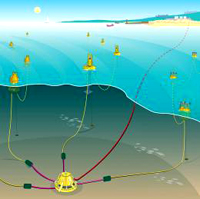 Last week we posted about Ocean Power Technologies (OPT) installation of offshore buoys off the coast of Oregon to capture and convert wave energy into electricity. It appears that they will also be playing a key role in the world’s largest wave energy site set to go live soon off the Cornish coast. The installation known as a “Wave Hub” is a sub-sea cable connecting t0 a socket with four 300 meter “tails” to which electricity producing wave generators will be attacked. wave OPT’s PowerBuoy will be connected to one segment of the project early next year. Other companies including WestWave, Fred Olsen Limited and Oceanlinx will also be connecting to the project.
Last week we posted about Ocean Power Technologies (OPT) installation of offshore buoys off the coast of Oregon to capture and convert wave energy into electricity. It appears that they will also be playing a key role in the world’s largest wave energy site set to go live soon off the Cornish coast. The installation known as a “Wave Hub” is a sub-sea cable connecting t0 a socket with four 300 meter “tails” to which electricity producing wave generators will be attacked. wave OPT’s PowerBuoy will be connected to one segment of the project early next year. Other companies including WestWave, Fred Olsen Limited and Oceanlinx will also be connecting to the project.
World’s biggest Wave Hub installed off UK coast
The $64 million project consists of a sub-station at Hayle in Cornwall, from which a cable has now been laid under the sand dunes and across the sea bed to the wave generation area 16 km offshore, where the energy generators will be moored. The area covers eight square kilometers, and is marked by navigational markers.
The subsea cable, socket, and four 300 meter “tails” of the Wave Hub have been lowered into position on the sea bed 55 meters below the surface, and work has begun on laying 80,000 tonnes of rock on top of the cable to keep it in place. Each of the four tail cable “berths” can be connected to up to a different wave energy conversion device.
The first wave generator developer to be signed up for the scheme is US company Ocean Power Technologies Limited (OPT), which will connect its PowerBuoy wave energy converter to one of the tail berths early next year.
Other companies expected to become involved are WestWave, Fred Olsen Limited and Oceanlinx. Each developer will lease a two square kilometer area of sea bed for a period of about five years, and will be able to generate a maximum of 4-5 MW of power, which will be sold and transmitted to the electricity distribution grid as the Wave Hub evaluates the efficiency of each device.
Executive director Stephen Peacock of the South West RDA said the project had been over seven years in the making, and will “catapult south-west England and the UK to the forefront of wave energy development.” The project is also expected to create hundreds of “quality” jobs in the region.

Pingback: OPT PowerBuoys on the Grid in Hawaii : Old Salt Blog – a virtual port of call for all those who love the sea
Pingback: Reserving Oregon’s Marine Environment for what?